Pimples on the chest and nipples not only indicate inflammation of the sebaceous glands in this area of the body. Their appearance is a kind of signal about some kind of disturbance in the body.
Let's look at the reasons why skin rashes occur, whether they are dangerous to health, and what therapeutic methods are used to eliminate them.
Causes of acne on the chest and nipples
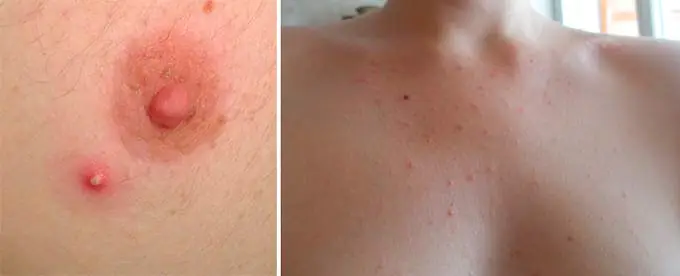
Why do acne appear on the chest, what factors contribute to its development? Medicine identifies several common causes of this unpleasant phenomenon:
| Cause | Why do they appear? |
| Blockage of sebaceous and sweat glands | The formation of numerous white pimples on the chest indicates blockage of the sebaceous and other ducts due to insufficient skin care or excessive production of fatty substances. |
| Allergy | Individual intolerance by the body to some perfume or cosmetic product is often manifested by the appearance of acne on the chest, nipples and other parts of the body. |
| Incorrect thermoregulation of breast skin | Poor ventilation of the skin of the mammary glands occurs when wearing a tight bra, especially if it is made of synthetics. If there is insufficient air supply, red pimples appear on and under the chest. |
| Endometriosis, hormonal abnormalities in the reproductive system |
For some women and girls, acne may appear before menstruation. As a rule, they disappear on their own after its completion. |
| Hormonal disorders | In approximately 1/3 of situations, acne on the papillae is caused by a hormone imbalance. Hormonal instability often disrupts the secretion of sebaceous substances and local immunity. Rashes that appear against the background of hormone deviations provoked by physiological processes in the body, such as puberty, pregnancy or breastfeeding, go away on their own after childbirth or completion of lactation. |
| Gastrointestinal diseases | If acne near or on the nipple is caused by gastrointestinal diseases, then in this situation characteristic symptoms appear: - diarrhea; - constipation; - heartburn; - stomach ache; - increased flatulence. |
| Uncompensated diabetes mellitus, immunodeficiency | The presence of these pathologies can lead to acne on the mammary glands and nipples. |
| Drug and food allergies | Individual intolerance of the body to certain medications or foods is a common cause of the development of pimples. |
| Cold | Often, acne on the nipples and chest is a side effect of a previous cold. |
| Insufficient breast hygiene | Sometimes acne or pimples appear due to failure to comply with basic hygiene procedures. |
| Stress | In stressful situations, a rash in the form of acne forms not only on the chest, but also on the back (along the spine), neck, and shoulders. |
Features of the pathological condition during pregnancy and lactation
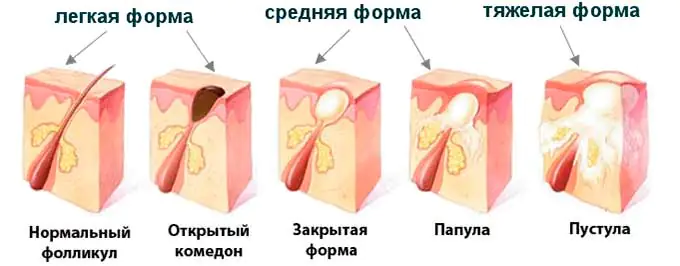
If white pimples appear on the papillae of women during pregnancy and lactation, then you should not squeeze them, as the formations may not be pimples, but Montgomery tubercles.
Montgomery pimples are special glands located on the areolar area of the female breast. In a pregnant or lactating woman, they often become more expressive, which is explained by the preparation of the mammary glands for feeding the child. An increase in Montgomery's pimples is one of the signs of pregnancy. The presence of such tubercles is normal and their treatment is not required.
Pregnant and lactating women sometimes experience such a nuisance as the appearance of real abnormal pimples around or on the nipple. They usually develop against the background of a hormonal “storm” in the female body, which is caused by the birth of a small life.
In this case, you should try to establish the nature of the acne:
| Classification | Varieties | Peculiarities |
| Inflammatory | Papules are red. Pustules are pustular formations. The nodules are burgundy-red papules. Cysts are subcutaneous pimples with pus. |
They are large in size. The skin next to them often turns red. You can see the contents through the skin. Often cause painful discomfort. |
| Non-inflammatory | Comedones: - open (small brown or black dots); - closed (wen). |
They look like dots or pimples. When infections are introduced into them, they immediately become inflamed and go into the “inflammatory” classification. |
The pathological condition in the form of acne on the chest during pregnancy and lactation, in addition to hormonal surges, is due to the following:
- Dehydration of the body.
- Excessively sensitive skin.
- Insufficient hygienic treatment of nipples after feeding the baby.
Usually, unpleasant rashes, if they are not caused by internal problems, disappear after the first months of pregnancy or after childbirth or completion of breastfeeding.
What are the consequences of having acne?

Doctors do not recommend squeezing pimples and blackheads in the chest area, much less cauterizing them. Such actions are fraught with:
- Formation of scars.
- Infection.
- Development of an abscess.
- Blood poisoning.
- A breakthrough of pus in the breast tissue.
If a pimple causes unpleasant discomfort and is accompanied by other clinical signs, you should consult a doctor.
Alarming symptoms
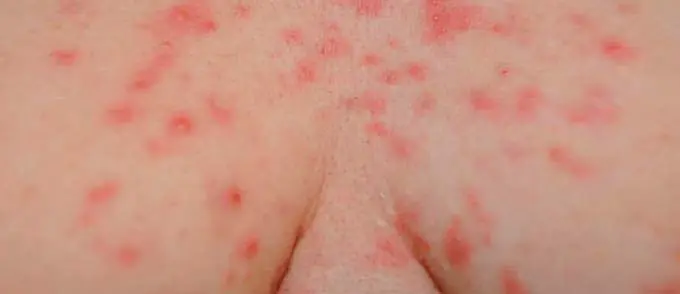
In most cases, pimples on the areolar-nipple area disappear on their own. However, if, when trying to squeeze them out, an infection was introduced into the subcutaneous layer, then alarming symptoms may appear:
- Montgomery's tubercles turn red and begin to hurt.
- Purulent fluid comes out of the nipple.
- After menstruation returns, the number of pimples and blackheads continues to increase.
- The pimple becomes inflamed and develops into a boil.
- Abnormal formations begin to itch very much.
- Inflammation of the areolar circumference.
- Increased body temperature.
- Acne does not disappear, but on the contrary, there are many of them.
Is it necessary to see a doctor?
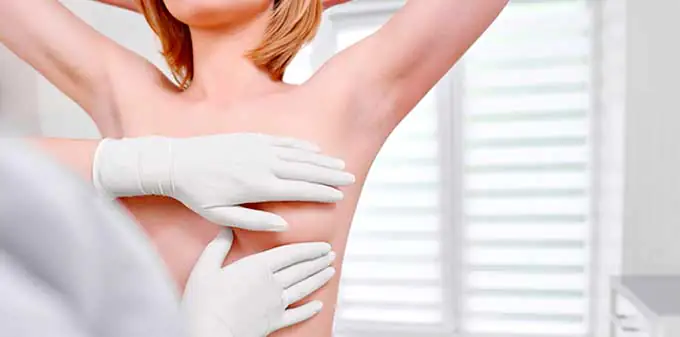
In case of regular appearance of acne and other rashes on the papilla and mammary gland, especially if there is a tendency to inflammation, you should visit a therapist.
In this situation, you may need to consult additional specialists:
- Dermatologist.
- Mammologist.
- Gynecologist.
- Cosmetologist.
- Allergist.
Highly specialized doctors will help determine the cause of the pathology and prescribe the appropriate treatment regimen.
In some cases, a comprehensive examination of the body is indicated, which makes it possible to determine the factor that provokes acne:
- Submission of laboratory tests.
- Ultrasound of internal organs.
- Ultrasound of the endocrine glands.
You cannot self-medicate, much less squeeze out pimples or remove them in some other way. Any illiterate actions increase the risk of widespread spread of the inflammatory process.
Ways to get rid of acne on the chest and nipples
How to remove acne on the chest and nipples, what medications and folk remedies can be used without harm to the body? Doctors highlight the following therapeutic points:
- Drug intervention.
- Regulation of diet.
- Wardrobe revision.
- Stabilization of hormonal status.
- Exclusion of perfumes and cosmetics.
- Compliance with hygiene procedures.
- Use of folk remedies.
Experts note that the elimination of skin abnormalities in the bust area and other areas of the body should be comprehensive.
Drug therapy
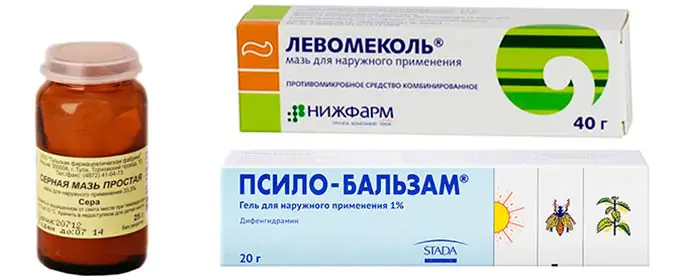
Drug treatment of acne on the nipples is practiced in cases where other treatment methods have not brought the expected effect. It is necessary not to forget that it is advisable to use any drug only with the permission of a doctor, this especially applies to pregnant and lactating women.
Based on the diagnostic results obtained, the following drugs are prescribed:
- Antiallergic.
- Antipruritic.
- Anti-inflammatory.
- Drying.
- Disinfectants.
- Vitamin complexes.
- Hormonal agents.
What can you put on a pimple before going to the doctor? External medications have a good therapeutic effect:
- Lokoid.
- Pantestin.
- Sulfuric ointment.
- Levomekol.
- Advantan.
- Psilo-balm.
- Salicylic-zinc ointment.
However, pregnant and lactating women should check with their doctor about the possibility of their use, since some substances may pass into breast milk or adversely affect the condition of the fetus.
Features of choosing underwear
If you have skin rashes in the mammary glands, you need to carefully choose a bra. The best option is hypoallergenic underwear made from natural fabrics.
Synthetics impair the process of thermoregulation and reduce the quality of air exchange in the skin of the mammary glands. As a result, the skin quickly sweats, thereby creating a favorable environment for the formation of acne.
However, it is not enough to pay attention only to the bra. It is necessary to carefully select clothing that is in direct contact with the body. Preference should be given to a wardrobe made from natural materials such as linen, viscose, silk, etc. However, wear woolen clothes with caution, since wool is an allergen for many people.
Folk remedies

Traditional medicine offers to get rid of acne on the papillae through herbal decoctions prepared on the basis of:
The selected component is poured with boiling water in a ratio of 1 tsp. herbs per 200 ml. liquid, heat in a water bath for 10-15 minutes and cool. The strained decoction is used to wipe problem areas with pimples. Pharmacy tinctures made from these herbs also have an effective effect, but they must be applied pointwise, applied to the skin with a cotton swab, without affecting healthy areas.
For acne and other similar manifestations on the chest, it is better to use tar soap for water procedures. As you know, its main component, birch tar, has a whole range of medicinal properties.
In addition, the following have a good healing effect:
When using these folk remedies, you should not wipe the nipple area too often or diligently to avoid injury. This precaution applies not only to women, but also to men, because their skin in the areola area is also quite vulnerable.
Before using any treatment option, be sure to consult a doctor about the possibility of their use in order to exclude allergic manifestations.
Exclusion of allergenic cosmetics and perfumes
Any cosmetics and perfumes, even the most expensive ones, negatively affect the skin, clogging its pores. During the period of fighting acne, you must refrain from using cosmetic products or reduce their use to a minimum.
At the end of the day, it is important to free the skin from remnants of cosmetics using special products with a cleansing effect (tonics, lotions, gels, etc.).
When purchasing cosmetic products, give preference to options with a minimal presence of perfumed fragrances.
Review of diet

Pimples on the nipples and breasts sometimes appear due to poor diet. Especially dramatic changes in diet are necessary for teenagers, who often suffer from acne and acne with the onset of puberty.
Balanced and healthy diet:
- Has a beneficial effect on the body.
- Helps improve the quality of the skin.
- To some extent helps normalize hormonal levels.
- Increases the capabilities of the immune system.
- Provides the body with useful substances.
With the systematic manifestation of pimples and blackheads on the papillae and breast, it is necessary:
- Eliminate large quantities of carbohydrates from your diet.
- Eat greens, fruits, vegetables and dishes made from them.
- It is important to eat foods rich in fiber.
- Minimize the consumption of animal fats.
- Preference is given to vegetable fats.
- Choose lean meat and fish.
- Limit consumption of confectionery products.
- Regularly introduce low-fat dairy and fermented milk products into the menu.
- If there are no contraindications, drink coffee and strong tea in reasonable quantities.
- Quit alcohol and smoking.
- Avoid excessive consumption of salt and salty foods (daily value - 3 g, taking into account other products containing it).
- Maintain daily fluid volume - the average norm is 1.5-2 liters.
- Preference should be given to whole grain baked goods.
- Prepare dishes by boiling, stewing, steaming, baking. When frying, use a minimal amount of fat.
- Do not go on strict diets, which is especially dangerous for young girls.
Compliance with basic hygiene procedures
Pimples on the papillae and areola in women can occur due to insufficient care of the mammary glands. Regular water procedures help get rid of skin problems, they are especially necessary if you are prone to blockage of the sebaceous and sweat glands.
It is necessary to shower 1-2 times a day (without soap), and in the hot season as often as possible.
If hygiene is not observed, dust and dirt particles are added to the sebaceous and sweat secretions. Such a mixture not only has a detrimental effect on the skin, but can also lead to inflammation.
Acne prevention
To prevent the formation of acne and pimples in the bust area, doctors recommend following simple rules:
- Review your diet.
- Wear a properly fitted bra.
- Maintain personal hygiene.
- Carry out air baths for the mammary glands.
- Adjust hormonal levels.
- Avoid stress and psychological stress.
- Visit a mammologist and gynecologist regularly.
- To live an active lifestyle.
- Exercise.
- Choose new cosmetics carefully.
- Strengthen the immune system with vitamin complexes.
- Change bedding in a timely manner.
Conclusion
Pimples on the chest are not only a cosmetic defect; they often indicate the presence of pathological processes in the body. If pimples occur with regular frequency, become inflamed and cause significant discomfort to the woman, it is necessary to consult a doctor to determine the cause of this condition.
Complete and sustainable relief from pathological manifestations is achieved only by complex therapy.
Hello, dear readers. Do women often look at their breasts in the mirror? It happens, especially during the period of bust growth, that is, puberty. If you find pimples on your nipples, once again, looking at your breasts in the mirror, should you be scared and run to the doctor. Or maybe you are pregnant and Montgomery tubercles have become noticeable?
Although, it would be a good idea to examine the breasts and the NAC area (nipple and areola) regularly (once a month) as part of a self-examination. Let's talk about what pimples on the areola (the dark circle around the papilla) can be. And what kind of things are they? Oh, we forgot another important point: we are talking about women, but do men have such formations?
Types of pimples

Actually, “pimples” is not a medical term. This is what skin formations are called in everyday life:
- in the form of a tubercle (tubercle) - an element without content, above which the color and structure of the skin changes (the tubercle is located in the second layer of skin - the dermis);
- nodule (papules) - an element without a cavity and contents, but with a low color of the skin;
- abscess (pustules) - a “pimple” with purulent or bloody contents;
- blister (urtica) - a cavityless pink formation, sometimes with a whitish tip.
Even the Montgomery glands fall into this category - these are normal formations, altered sebaceous glands located under the skin of the areola.
What do pimples look like?
What are these formations or elements? I would like to say how girls are different. These formations differ:
- by color (color unchanged, white, black, brown, red);
- pain (painless, slightly painful, very painful);
- the absence or presence of cavity and contents in each element;
- quantity (single, multiple);
- size (small, large).
Now let’s go from normal to serious pathology. The norm is separated from a threatening disease by only 4 steps.
Step 1 Normal: Montgomery tubercles
Montgomery's glands (areolar glands, glandulae areolares) are formations located on the areola along the periphery of the nipple:
- painless;
- no change in skin color SAH;
- secrete a special secretion that moisturizes the areola and enhances the baby’s desire to suckle milk;
- There are usually 10-12 such formations in quantity (the minimum number is 4, the maximum is 28, always even).
These glands become noticeable in women during pregnancy. Visible during the entire period of feeding the baby. Then they gradually “dissolve” (become invisible). In girls they can be noticeable during puberty. Montgomery's glands don't hurt!
In men, these glands are normally not visible.
If the bumps become red, pain appears - this is no longer the norm. Hyperemia (redness) is a sign of inflammation. And you need to see a doctor. The cause of inflammation of these glands may be infection or hormonal imbalance.
Step 2 Pimples are not the norm, but not catastrophic
Atheroma| Allergy | |
| Benign neoplasm, tumor, wen | Small multiple rashes (vesicles, urticarial rash) |
| May be slightly painful or painless when pressed | The rash is very itchy |
| Does not pose a threat to life | The skin defect can become infected. Constant itching causes neuroses |
| Formed as a result of blockage of the sebaceous duct | Develops due to dietary errors, wearing synthetic underwear, contact with chemical reagents |
| Looks like a white pimple | Appear as red or pink small rashes that may coalesce |
| If necessary, removed by a surgeon | Treatment with antihistamines, calcium supplements, and less often hormones is required |
Step 3 Bumps are more dangerous
Furuncle| Psoriasis | Benign mole (nevus)* | Papilloma, wart | Herpes on the chest | |
| Boil is a purulent inflammatory process of the hair follicle with purulent melting of tissue | Non-communicable disease with a chronic course | Large, medium and small formations (pimples, tubercles) near the nipple | Single or multiple lesions near or around the nipple, light to dark brown | Multiple blisters with clear or yellowish contents |
| A boil is a painful element. Dangerous due to the possibility of bacteria entering the blood and developing septicemia or mastitis | The formations are very itchy | Painless, not dangerous, but if damaged they can become malignant (rarely degenerate into melanoma) | Painless, not dangerous, but if damaged they can become malignant | Very itchy |
| Requires treatment: antiseptics, antibiotics | Requires special treatment | Needs to be treated with antiviral drugs | ||
| Occurs due to the penetration and proliferation of bacteria in the follicle (due to stress, poor hygiene, injury to the SAC with underwear) | The causes of the disease are not fully understood. Doctors assign the main role to disruption of the nervous system; additional factors are considered: infection and heredity | Presumably occur due to hormonal stress (including during pregnancy), after psychological trauma or physical damage to the nipple. The exact cause has not been established | They arise due to hormonal imbalances, the presence of parasites in the body, disruption of the pancreas, or the penetration of the human papillomavirus (HPV). Among the many HPV strains there are also oncogenic strains (cancer-causing) | Occur due to the penetration of the herpes virus through damaged skin or reactivation of a “dormant” virus in the body after stress, hypothermia, or drinking alcohol |
| Looks like a red and large pimple with a white “head” against the background of erythema (redness of the skin SAC) | It occurs rarely on the chest and usually after injury. The rash appears as round papules in the SAH area, which may coalesce | It looks like a light brown, tan or brown bump. Less often, the tubercle is red - this is a vascular nevus | Looks like a light brown, brown or cinnamon small papilla or bump | Fluid-filled blisters against reddened skin |
| Attention: do not squeeze the boil on the areola! This can lead to infection penetrating deep into the gland and mastitis. | The rash causes moral and physical discomfort, neuroses (due to severe itching). Fabrics may appear due to scratching (bacterial or fungal infection is associated) | Moles can become injured, infected and inflamed | Both warts and papillomas can become inflamed and increase in size due to stress, injury or hormonal surge | Treatment is necessary; if you are breastfeeding, you will have to temporarily wean your baby off the breast. Attention: opening bubbles contain many viruses. |
* - Flat moles usually do not pose a threat. But those rising above the surface are dangerous because they can damage them, cause infection, or provoke malignancy (degeneration into a malignant neoplasm).
All these elements, formations, acne appear in both men and women. In women, more often due to physiological hormonal disturbances (menstruation, pregnancy, menopause).
Step 4 Threat! Threat!
Paget's cancer is a malignant process that occurs mainly in the area of the SAH. It is diagnosed not only in women, but also in men.
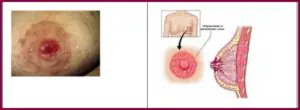
Why such a lesion of the SAH develops is not exactly clear. Usually this disease is combined with other forms of breast cancer. At the initial stage of the disease, the nipple itches, peels, and may be covered with small pimples. As the disease progresses, pain, burning, tingling, discharge from the nipple, and ulcers appear.
For this disease, both surgery and auxiliary treatment (chemo- and radiation therapy). The disease is life-threatening for the patient.
Melanoma-dangerous breast moles are another type of potentially dangerous neoplasm. These moles are benign, but often develop into melanomas.
The cause of the disease is a violation of the division of melanocytes (pigment cells of the skin).
Such formations look different. They can be brown, black, light (almost yellow), and the edges are usually fuzzy. The formations are large and differ in consistency from the surrounding tissues. There are several types of such neoplasias (neoplasms).
If you have any pimples in your SAH area, don’t panic, but be sure to consult your doctor. Do this as quickly as possible so as not to trigger the disease if it is dangerous or potentially dangerous.
This concludes our review of the topic of pimples in the field of SAH, and we say goodbye to you. We hope our article gave you food for thought and helped you choose further behavior. Visit our website again and share the article with your friends via social networks.
The pimples on a woman’s nipples are rudimentary glands, the functions of which have not yet been studied. They often have a negative impact on the appearance of the breasts, and can also bring significant discomfort to the woman. How normal is this process and why does this happen? There can be a lot of reasons: from standard changes in hormonal levels to an infectious disease. These are the ones that need to be examined in more detail.
What do the pimples around the nipple mean?
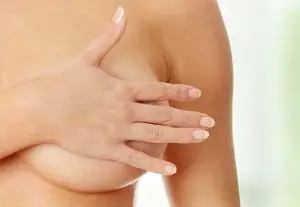
The tubercles in the area of the areola of the juice are modified sebaceous glands. The tubercles in the nipple area secrete a secretion, but what it is intended for is not completely clear. One version is that this lubricant, which contains a lot of fat, serves to protect the areola from drying out. Another version says that these secretions from the glands have bactericidal properties. In many cases, it was noticed that during pregnancy milk came out from these tubercles on the nipples.
One of the most interesting versions is that it is believed that there is a direct dependence of the number of tubercles on the characteristics of baby food. After conducting a series of studies, it was possible to establish the presence in this liquid of substances that direct the baby’s sense of smell to them, such a kind of natural taste enhancer. At the moment, scientific work is being carried out on the artificial synthesis of this substance for further use in accustoming premature babies to breastfeeding.
Why do bumps appear and when does this happen?
There are many reasons for the appearance of unattractive protrusions in the nipple area. Here are some that are considered the most common:
- presence of Montgomery tubercles;
- tubercles formed in response to changes in hormonal levels (most often occurs during puberty and during pregnancy);
- blockage of the sebaceous glands with secretions (acne);
- pathological diseases of the skin (eczema, psoriasis, dermatitis);
- allergic reactions.
Similar rashes occur in women of different age categories and in varying quantities. They can be single, several on the nipple, or they can be multiple, filling a large area of the areola. They look like a point that protrudes slightly above the surface of the skin and surrounds the nipple.
It is common to see up to 15 pimples on one breast.
When pimples appear in the last stages of pregnancy, this indicates the imminent arrival of milk, and as is already known, there is an opinion that the more units surround the nipple area, the more milk the new mother will have.
The appearance of this phenomenon during pregnancy is due to hormonal changes in the body of the expectant mother. These bumps are clearly visible throughout the entire breastfeeding phase. However, when the moment of lactation passes, Montgomery succumbs to regression and passes without a trace.
The appearance or increase in the number of tubercles, in some cases, is the first examination of the onset of pregnancy. In some pregnant women, they become inflamed from the very first days after conception, becoming the primary source of successful fertilization of the egg.
If such pimples appear as a result of pregnancy, then women should not worry; their presence in this case is considered normal and does not cause any harm to health, and also does not require treatment. Some women try to squeeze out the contents of the bumps, but this manipulation is unsafe, since through open pores there is an increased likelihood of infection and subsequently harmless bumps will cause a lot of problems and lead to complications.
There are incidents in which an inflammatory process occurs in the tubercles, which is quite common. A mammologist or gynecologist can diagnose such a problem. During inflammation, the tubercles turn red and pain is present. At the first manifestations, a chamomile decoction will be useful; it can cope with the initial stage. But if symptoms do not disappear, you should consult a doctor. It is not advisable to expose your breasts to overheating or apply hot compresses; these are favorable conditions for the development of bacteria. If an inflammatory process occurs during breastfeeding, you should stop feeding for a while until a definitive diagnosis is made.
Abnormal causes
In addition to natural physiological causes, there are also pathological deviations, as a result of which pimples appear on the nipples. There are several types of this pathology:
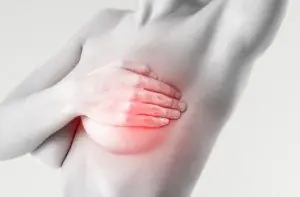
Furuncle. The skin of the breast areola is very delicate, so when this area is traumatized, infections quickly begin to arise in them, especially if this occurs along with reduced immunity. Such an infection in some cases leads to the appearance of furunculosis. This reason for the appearance of tubercles on the nipples is not exceptional and occurs quite often. At the slightest suspicion of this disease, you should consult a dermatologist, since this process is a dermatological disease.- Acne. During hormonal changes during puberty, the functioning of the sebaceous glands worsens in girls. The ducts of the sebaceous glands become clogged with the secretion produced and red, inflamed lesions with a white purulent top and sometimes with black dots appear. Such rashes appear mainly on the face, but can also occur on the nipples.
- Atheroma. The secretory fluid produced from the glands near the nipples serves as a protective barrier against infections and prevents cracking. However, when the duct becomes clogged, this secretion accumulates in the thickness of the skin, and a white purulent pimple forms on its surface, when pressed on, discomfort and pain are felt. Such a lesion is called atheroma and it belongs to the category of benign neoplasms that do not pose a threat to a woman’s life. Although, like other pathological phenomena, it should not be ignored and measures must be taken to eliminate it.
- Paget's syndrome. Its appearance is caused by a malignant mole on the chest, which can cause a malignant tumor. This disease affects the surrounding area of the nipple. Breast cancer causes the appearance of pimples in the breast area. The diagnosis is established after a series of tests. If characteristic signs of this disease appear, you should not postpone your visit to medical institutions.
- Eczema. A common disease of the epidermis. When the epithelium of the mammary glands is damaged, small warts appear on its surface. Often, the provocateur of such an illness is nervous tension, allergic reactions, disruptions in the endocrine system, and underwear made of synthetic materials.
- Allergy. Allergic manifestations on the nipples are characterized by the appearance of an inflammatory rash. After microcracks appear in their thickness, infection develops, accompanied by a small rash, itching and redness of the affected areas. Outwardly, these look like small blisters, from which clear or cloudy liquid can sometimes flow. Allergic reactions are reversed by antihistamines and the exclusion of allergens from daily life.
Treatment of pimples and bumps on the nipples

Of course, to initially solve the problem, a correct diagnosis must be made. A visit to a dermatologist or mammologist will help in this matter; if the inflammation coincides with the period of pregnancy, then a consultation with a gynecologist will be enough. Often a woman worries in vain about an ordinary mole that does not cause harm or discomfort. But there are also formations that do not require delay in treatment. Some manifestations are difficult to detect with the naked eye, and only a professional can handle this.
Montgomery's bumps are normal and do not require treatment. If there is inflammation, redness, pain and discharge of purulent contents, it is better not to delay the visit to the doctor. For such symptoms, physiotherapy, ointments with an antiseptic effect, and homeopathic remedies may be prescribed.
Treatment of eczema involves individual selection of the most effective technique, since the causes of this pathology are purely personal for each patient. Whether it is chronic diseases of internal organs or mental disorders, it is necessary to conduct tests, based on the results of which therapy is selected.
Drug treatment may consist of antihistamines, sedatives and immunomodulating drugs, as well as ointments or creams for external use that relieve itching, inflammation and irritation.
Acne can be easily removed with basic personal hygiene rules and the correct selection of cosmetics and underwear. Shower gels can have a slightly drying effect, and underwear is made from natural fabrics that allow air to circulate without difficulty.
Along with drug treatment, you should slightly adjust your usual routine. It is recommended to follow a diet. Include foods rich in vitamins in your diet, consume more vegetables, fruits, grains, replace steamed dishes with fried ones. And try to eat at the same time. It is better to give up fatty, smoked, sugar and baked goods. And also maintain daily hygiene. It is good to use tar soap several times a week, and the result will not be long in coming.
>



